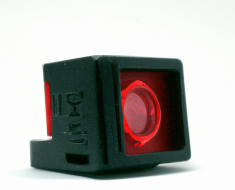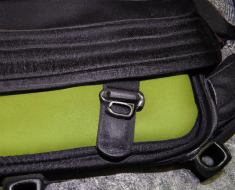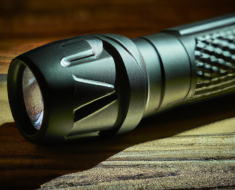Choosing the right tool for the job.
Benefits of Weapon Lights for Accuracy
When it comes to enhancing accuracy in low-light situations, weapon lights are an essential tool for any shooter. These compact devices are mounted directly onto firearms and provide a bright, focused beam of light to illuminate targets in dimly lit environments. By illuminating the target, shooters can more effectively acquire and engage their aim, resulting in improved accuracy and target identification.
One of the key benefits of using a weapon light for accuracy is the ability to clearly see and distinguish your target in low-light conditions. Whether you’re in a dimly lit room or outdoors at night, having a weapon light attached to your firearm can make all the difference in being able to accurately identify your target before taking a shot. This increased visibility not only improves accuracy but also helps to reduce the risk of mistakenly shooting at innocent bystanders or non-threats.
In addition to enhancing target identification, weapon lights also help to improve shot placement by providing a clear sight picture for the shooter. With the added illumination from the weapon light, shooters can better align their sights with the target, resulting in more precise and accurate shots. This is especially important in high-stress situations where split-second decisions need to be made, as having a weapon light can give shooters the confidence they need to make accurate shots under pressure.
Furthermore, weapon lights can also help to reduce the time it takes for shooters to acquire their target, leading to faster and more efficient engagements. In low-light scenarios, it can be difficult to quickly locate and aim at a target without proper illumination. By using a weapon light, shooters can instantly illuminate their target and acquire their sight picture without wasting precious seconds trying to find their aim. This quick target acquisition not only improves accuracy but also increases the shooter’s overall efficiency in engaging multiple targets or moving threats.
Another advantage of using a weapon light for accuracy is its versatility in various shooting scenarios. Whether you’re conducting home defense, law enforcement operations, or tactical training exercises, a weapon light can be a valuable asset in improving accuracy across different environments and situations. From close-quarters engagements to long-range shots, having a reliable source of illumination on your firearm can give you the edge you need to effectively engage targets with precision and confidence.
In conclusion, weapon lights are an essential tool for enhancing accuracy in low-light situations. By providing increased visibility, improving shot placement, aiding in quick target acquisition, and offering versatility across different shooting scenarios, weapon lights play a crucial role in helping shooters achieve greater accuracy and effectiveness with their firearms. Whether you’re a civilian gun owner or a law enforcement officer, investing in a quality weapon light can make all the difference in your ability to accurately engage targets and stay safe in low-light environments.
Advantages of Lasers for Quick Target Acquisition
When it comes to equipping your firearm for optimal performance, there are a variety of accessories to choose from. Two popular options for enhancing your shooting experience are weapon lights and lasers. While both serve important purposes, lasers offer some distinct advantages when it comes to quick target acquisition.
One of the primary benefits of using a laser on your firearm is the ability to quickly and accurately acquire your target. Unlike traditional iron sights or even red dot sights, lasers provide a visible point of aim that is projected onto the target itself. This can be especially helpful in low-light situations where it may be difficult to see traditional sights.
Additionally, lasers allow for faster target acquisition because they eliminate the need to align front and rear sights. With a laser, you simply place the dot on your target and pull the trigger. This can be particularly useful in high-stress situations where every second counts.
Another advantage of using a laser for quick target acquisition is the ability to shoot accurately from unconventional shooting positions. Whether you are shooting from behind cover, around a corner, or while on the move, a laser allows you to maintain proper sight alignment without having to expose yourself unnecessarily.
Furthermore, lasers can help improve your shooting accuracy by providing instant feedback on your trigger control and follow-through. By watching how the laser moves on the target as you press the trigger, you can identify any errors in your technique and make adjustments accordingly. This real-time feedback can be invaluable for improving your shooting skills.
In addition to aiding in quick target acquisition and improving shooting accuracy, lasers can also help increase your confidence when shooting in challenging conditions. Whether you are dealing with low light, fog, smoke, or other environmental factors that can obscure your sight picture, a laser provides a clear point of aim that is unaffected by these conditions.
Overall, lasers offer several advantages for quick target acquisition that make them a valuable addition to any firearm. From their ability to provide a visible point of aim in low-light situations to their real-time feedback on shooting technique, lasers can help improve your shooting performance in a variety of scenarios.
In conclusion, while weapon lights certainly have their own set of benefits, lasers excel when it comes to quick target acquisition. Their ability to provide a visible point of aim, eliminate the need for sight alignment, and offer real-time feedback on shooting technique make them an invaluable tool for shooters looking to enhance their performance. So if you’re looking to improve your speed and accuracy on the range or in a self-defense situation, consider adding a laser to your firearm setup.
Considerations for Choosing Between Weapon Lights and Lasers

When it comes to enhancing your accuracy and visibility in low-light situations, having the right accessories for your firearm can make all the difference. Two popular options for improving your shooting performance in the dark are weapon lights and lasers. But which one do you really need? Let’s take a closer look at the differences between these two accessories to help you make an informed decision.
Weapon lights, also known as tactical lights, are designed to illuminate your target in low-light conditions. These lights are typically mounted on the rail of your firearm and provide a bright beam of light that helps you identify potential threats and improve your accuracy. Weapon lights come in a variety of sizes and brightness levels, so you can choose one that best suits your needs.
On the other hand, lasers are devices that project a beam of light onto your target, allowing you to quickly and accurately aim your firearm. Lasers are especially useful in situations where you need to acquire targets quickly or when shooting from awkward positions. Like weapon lights, lasers can be mounted on the rail of your firearm for easy access.
One key difference between weapon lights and lasers is their intended use. While weapon lights are primarily used for illuminating targets in low-light conditions, lasers are used for aiming and targeting. If you frequently find yourself in situations where visibility is poor, a weapon light may be the better option for you. However, if you need help with aiming and acquiring targets quickly, a laser may be more beneficial.
Another factor to consider when choosing between weapon lights and lasers is their effectiveness at different distances. Weapon lights are great for illuminating targets at close range, making them ideal for home defense or indoor shooting. However, at longer distances, the beam of light from a weapon light may not be as effective. On the other hand, lasers can be used to accurately aim at targets both near and far, making them versatile accessories for shooters of all skill levels.
In terms of battery life, weapon lights tend to have longer run times compared to lasers. This is because weapon lights use LED technology, which is energy-efficient and provides bright illumination for extended periods of time. Lasers, on the other hand, require more power to project their beams onto targets, resulting in shorter battery life.
When it comes to cost, weapon lights are generally more affordable than lasers. This is because weapon lights are simpler devices that do not require as much technology to operate. Lasers, on the other hand, use advanced optics and electronics to project their beams onto targets, making them more expensive to manufacture.
In conclusion, both weapon lights and lasers have their own unique advantages and disadvantages. When choosing between these two accessories, consider factors such as intended use, effectiveness at different distances, battery life, and cost. Ultimately, the best accessory for your firearm will depend on your specific needs and preferences. Whether you choose a weapon light or a laser, having the right accessory can greatly improve your shooting performance in low-light conditions.
Comparison of Effectiveness in Low Light Conditions
When it comes to choosing the right tool for low light conditions, many firearm owners debate between weapon lights and lasers. Both options have their own set of advantages and disadvantages, making it important to understand the differences between the two in order to make an informed decision.
Weapon lights are designed to provide illumination in dark environments, allowing shooters to identify their targets and aim with greater precision. These lights are typically mounted on the firearm itself, either on the frame or on a rail system. When activated, the light beam illuminates the area in front of the shooter, making it easier to see and engage targets.
One of the main advantages of weapon lights is their ability to provide a broad and even beam of light, which can help illuminate a larger area and make it easier to spot threats in low light conditions. This can be especially useful in scenarios where there is limited ambient light or when shooting in enclosed spaces.
On the other hand, lasers are designed to project a small dot onto the target, providing a visual reference point for aiming. While lasers do not provide illumination like weapon lights do, they can be highly effective in helping shooters acquire and maintain sight alignment in low light conditions.
The key advantage of lasers is their ability to help shooters quickly acquire targets and maintain accuracy, even in situations where visibility is limited. By projecting a visible dot onto the target, shooters can easily track their aim and make adjustments as needed.
In terms of effectiveness in low light conditions, both weapon lights and lasers have their own strengths. Weapon lights excel at providing illumination and helping shooters identify threats, while lasers are highly effective at aiding target acquisition and maintaining accuracy.
When choosing between weapon lights and lasers for low light conditions, it ultimately comes down to personal preference and intended use. Some shooters may prefer the broad illumination provided by weapon lights, while others may find the precision offered by lasers to be more beneficial.
Ultimately, the decision between weapon lights and lasers should be based on individual needs and preferences. Shooters who frequently find themselves in dark environments or enclosed spaces may benefit more from a weapon light, while those who prioritize quick target acquisition may prefer a laser.
It’s also worth noting that some shooters choose to use both weapon lights and lasers in tandem, combining the benefits of both tools for maximum effectiveness in low light conditions. By using a weapon light for illumination and a laser for aiming, shooters can enhance their overall performance in challenging lighting scenarios.
In conclusion, both weapon lights and lasers have their own unique advantages when it comes to effectiveness in low light conditions. Understanding the differences between these tools can help shooters make an informed decision based on their individual needs and preferences. Whether you choose a weapon light, a laser, or both, having the right tool for low light shooting can greatly enhance your performance and safety on the range or in the field.
Training Tips for Using Weapon Lights and Lasers
When it comes to enhancing your shooting accuracy and target acquisition in low-light situations, having the right tools can make all the difference. Two popular options for improving visibility in these scenarios are weapon lights and lasers. But which one should you choose? In this article, we’ll explore the differences between weapon lights and lasers to help you determine which one is best suited for your needs.
Let’s start by discussing weapon lights. Weapon lights are mounted directly onto your firearm, typically on the rail system. These lights provide illumination to help you see your target clearly in low-light environments. The primary benefit of using a weapon light is that it allows you to identify potential threats and accurately aim your firearm in situations where natural light is limited.
One of the key advantages of weapon lights is their versatility. They can be used for a variety of purposes, including home defense, law enforcement operations, and hunting. Additionally, many modern weapon lights are compact and lightweight, making them easy to carry and use on a daily basis.
On the other hand, lasers offer a different set of advantages. Lasers are small devices that emit a visible beam of light onto your target, providing a clear reference point for aiming your firearm. The main benefit of using a laser is that it allows for quick and precise target acquisition, especially in high-stress situations where you may not have time to align your sights properly.
One of the key advantages of lasers is their ability to improve accuracy at longer distances. By projecting a beam onto your target, lasers help you maintain a consistent sight picture and ensure that your shots land exactly where you intend them to. This can be particularly useful for shooters who need to engage targets at extended ranges or in low-light conditions.
While both weapon lights and lasers have their own unique benefits, it’s important to consider how each tool fits into your overall shooting strategy. For example, if you primarily shoot in low-light environments or need to quickly acquire targets in high-stress situations, a laser may be the better option for you. On the other hand, if you need to positively identify threats before engaging them or require illumination for target identification, a weapon light may be more suitable.
Ultimately, the decision between using a weapon light or laser comes down to personal preference and the specific requirements of your shooting activities. Some shooters may find that using both tools in conjunction offers the best results, allowing them to benefit from the advantages of each device.
When selecting a weapon light or laser for your firearm, be sure to consider factors such as brightness, battery life, durability, and ease of use. It’s also important to practice with your chosen device regularly to ensure that you are comfortable and proficient with its operation.
In conclusion, both weapon lights and lasers can be valuable tools for enhancing your shooting performance in low-light situations. By understanding the differences between these two devices and considering how they fit into your shooting strategy, you can make an informed decision on which option is best for you. Whether you choose a weapon light, laser, or both, remember that proper training and practice are essential for maximizing the benefits of these tools on the range or in real-world scenarios.






